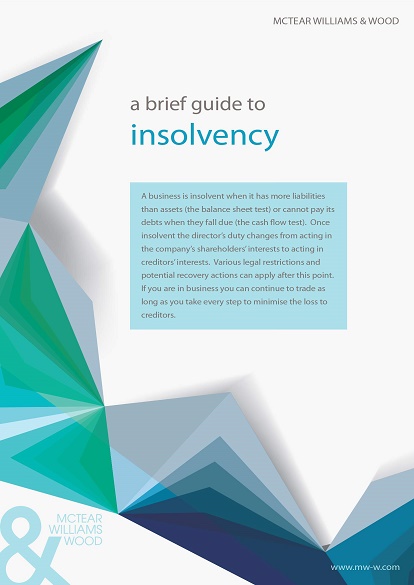How does a Charity or not for profit organisation handle insolvency?
Non charitable businesses have boards of mostly executive directors and management structures are in place with the senior personnel who manage the day to day activities, as well as monitoring long term strategies. This is not the same for charities where a board of Trustees, often volunteers who are non executive, will look after governance, strategy and finance for the charity and the day to day operations will likely be overseen by managers. Careful monitoring of budgets, accounts, projects and other financial reports for the enterprise will provide important indicators on the overall financial health of the charity.
Early Warning Signs
Just like regular businesses early warning signs of potential insolvency could include:
- The Charity is unable to pay its debts as and when they become due; and/or
- The Charity's assets are worth less than its current liabilities
Often one situation or incident can lead to Trustees becoming concerned with the financial position of the charity, for example, failure to obtain a grant or donation which had historically always been received and relied upon, a change or loss of a key member of staff or something completely unforeseen that causes cash to run low and cashflow forecasts to predict deficits.
These could indicate potential insolvency for the charity, at which point the Trustees should not delay and seek immediate professional advice from a Licensed Insolvency Practitioner to ensure the situation does not get any worse. An Insolvency Practitioner can offer expert support and advice on what action should be taken. If however Trustees are concerned with the financial position of the charity, we would recommend that they should:
- Hold regular Trustee meetings to capitalise on the board's skill set:
- Minute all decisions made, particularly those which may have a financial impact;
- Maintain up to date financial records which are accurate and realistic;
- Ensure sufficient unrestricted reserves are available to fund a potential insolvency procedure if required.
The Charity Commission states that in the event of a potential charity insolvency Trustees should seek immediate advice.
Can a charity still operate when insolvent?
Whilst a charity is insolvent it does not have to cease operations or immediately look to enter into an insolvency procedure. If the charity continues to operate however it should only continue with great care so not to worsen the position for creditors.
The Charity Commission expects Trustees to address any potential insolvency concerns promptly to ensure a plan for an orderly shutdown is in place where necessary. Trustees should seek advice at an early stage whether that is initially from their accountant or directly from a Licensed Insolvency Practitioner. If you take and follow professional advice then the Trustees effectively pass the risk on to their advisers.
Other available options
It is important to be aware that just because a charity may be technically insolvent, it does not necessarily have to cease operations or immediately look to enter into an insolvency procedure. There are often steps that can be taken to return the charity to solvency and continue operations.
As referred to above, the Charities Commission will expect Trustees to address any insolvency issues together with having a plan for an orderly shutdown. In a situation where cashflow permits and there is sufficient time available it may be possible to negotiate a merger or transfer of resources to a successful charity with similar objectives. This would hopefully allow for the service supplied by the charity to continue and protect any vulnerable individuals.
Charity structures
Charities can be in the form of several different structures and as a result can be subject to different insolvency procedures. A charity's structure is defined by its governing documents. Below are examples of the more typical structures adopted by charities and whether that structure is incorporated or not.
- Charitable incorporated organisation ("CIO") - incorporated
- Charitable company limited by guarantee - incorporated
- Unregistered company - unincorporated
- Unincoporated association (usually small charities) - unincorporated
- Trusts - unincorporated
If we find the charity is insolvent and a formal insolvency procedure is unavoidable there are several insolvency procedures available dependent on the charity's structure.
Below are the procedures available split between those applicable to incorporated and unincorporated entities.
Incorporated charities:
- Company Voluntary Arrangement
- Administrations
- Creditors' Voluntary Liquidation
- Compulsory Liquidation
- Members' Voluntary Liquidation (please note this procedure is only applicable for solvent entities seeking an orderly wind down).
Unincorporated charities:
Whilst Trustees have a duty to comply with the charity's objectives they will also have a duty to the creditors of the charity in the event of insolvency. In some circumstances trustees can be held personally liable for the charity debts.
These might include:
- Wrongful trading - allowing the charity to continue to trade whilst insolvent resulting in an increase in amounts owe to creditors.
- Breach of fiduciary duty or misfeasance.
- Fraud.
- Preferences.
- Transactions at undervalue.

- Limited by guarantee - if the charity is limited by guarantee Trustees will be required to repay the amount equivalent to the value of their guarantee when the charity enters an insolvency procedure.
- Breach of trustee agreements.

We have extensive experience working with charities, not for profit organisations and charitable trusts and have a number of solutions available that trustees may not have even considered.
These restructuring solutions can often result in the charity avoiding having to enter any formal insolvency procedures, returning to solvency and continuing to operate in the future.
Take action and seek advice
As mentioned previously The Charity Commission states a charity must seek advice immediately if they are facing signs of insolvency as doing so will likely provide the best possible outcomes for creditors.
Call Anthony Davidson on 0800 331 7417 or any of our senior team to discuss your individual circumstances.

